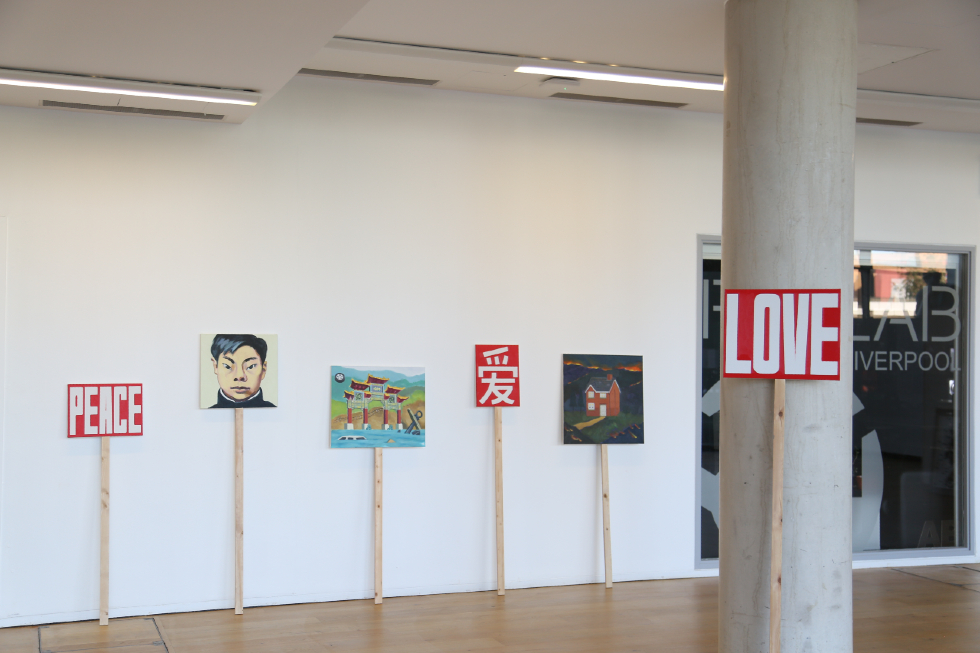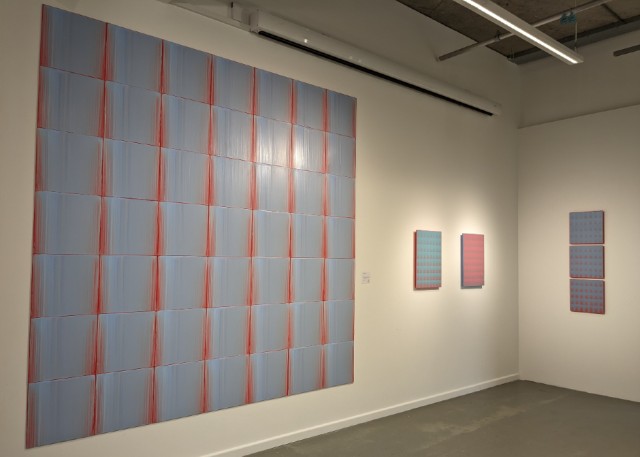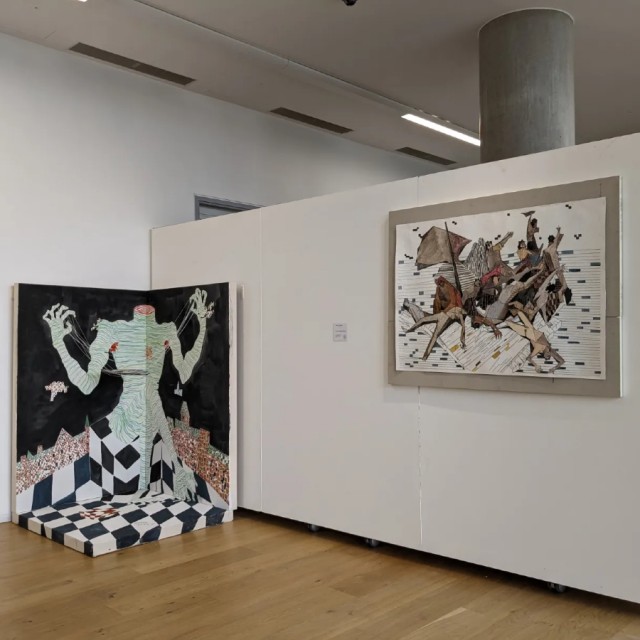2020 & 2022 John Moores Painting Prize China Winners Group Show

“A celebration of prize-winning artists.” Mike Pinnington reflects on the 2020 & 2022 John Moores Painting Prize China Group Show…
There has long been misguided talk about painting having reached the end of the road. That nothing more of interest could be done with the medium which had given us da Vinci, Rembrandt, Gentileschi, Van Gogh, Cézanne, Picasso, O’Keefe. Add to or take away from the pantheon as per your own taste – the list of artists who have contributed to our understanding of the world is as long as a piece of string. There, of course, remains serious conversation and debate to be had about so-called Zombie Abstraction and – more recently – Zombie Figuration. Each named for a lack of evolution in their respective forms, they play very well on Instagram if not with critics.
But away from the seductive allure of social media, many artists continue to strive to say something interesting as opposed to making decorative identikit art for living room walls. Certainly, from my 2023 vantage point, painting isn’t (un-)dead. If anything, released from the shackles of conforming to one art movement or another in any given period, and with an acknowledgement, finally, that painting also happens away from London, Paris or New York – and is sometimes even made by women – its transportational potential seems revitalised. Exposure to art made by those with names Microsoft Word doesn’t recognise, in other countries and from different cultural perspectives than our own, can be both eye-opening and thrilling.
All of which brings me to the John Moores Painting Prize which, since 2010, following a partnership with the Fine Arts Academy of Shanghai University, has showcased contemporary Chinese painting in Liverpool, home to the oldest Chinese community in Europe (and also the largest Chinese Arch). The relationship is apt – Liverpool and Shanghai having been made twin cities in 1999. This year, following the previous iteration’s lockdowns-hit compliment of Chinese artists’ works appearing at the Walker via projector only, all ten winners from a combination of both the 2020 and 2022 prizes have spent a month in the studio at the Liverpool School of Art and Design, and work created during the residency is currently on display at LJMU’s Exhibition Research Lab.

Including markedly different styles and traditions, the selection takes up two levels of the art school. Beginning with the ground floor’s Exhibition Research Lab, things are off to a strong start with the Buddhism-infused process-emphasising abstraction of Peng Yong (above). In acrylic on PVC board, with finely applied repeated brush strokes of gradients of blue and red, the grouping is clustered together under variations of the shared title 3000 Realms in a Single Moment of Life. You could easily get lost in those brush strokes. Transporting the viewer from the corporeal world and immersing them in the spiritual, it seems not impossible to glimpse, in the mind’s eye at least, those 3000 realms of the title.
Emerging, almost blinking into the light to reorientate oneself, nearby you’ll encounter a number of pieces by You Xin. The contrast between them – in palette and material – is stark; on first viewing I mistook them for the work of two different artists altogether. Rendered in charcoal powder, Holidays, Story, and The Start of Autumn (all 2023) evoke mournful grey days – most probably Sunday – spent whiling away the hours peering dolefully at the world from behind a windowpane made blurry by the constant streaming of rain. Melancholic and beautiful, these were created during the artist’s frequently sodden stay in Liverpool and capture the at first incremental and then sudden lurch into the darker days of a new season. In glorious technicolour, the other pieces on display here have more to do with op art than elegiac mood; they are no less successful for that. Utilising optical pigment, these demonstrate how You Xin employs colour, angle and light to change and dictate the viewer’s experience of them.
Similarly inviting viewers to consider their role in the gallery as dynamic rather than merely passive is Jin Dawei. His canvases (all 2023) hang from the ceiling, bisecting the space; they subtly punctuate flow and our perception. Provoking a different multi-dimensional feel, they open a dialogue that isn’t always available in the usually 2D, framed and wall-mounted world of painting. Li Qing’s figurative quartet, meanwhile, is all about narrative. Elegant, and leaning toward the surreal, her paintings are full of imposing, monolithic buildings. From them, fragments, scenes, even fully formed stories seem to flow; the doors, windows, and other architectural fissures in these feats of engineering are heavy with implication. One made this year is called Going on a Long Journey. The road less travelled. An underlying sinister atmosphere pervades. A frisson of warning that it may not always be wise to accept the voyage of discovery offered. There is no visible human presence – perhaps we are the unwitting intended protagonist here, ensnared within the confines of expertly mood conjured in paint.
Downstairs, you’ll find the work of Wang Longwei (below), an art teacher by trade who uses his cubist-inflected art as an expression both of his identity and the state of the world. In A Practice on the Raft of Medusa (2022) we see a wretched decapitated figure – who we’d hazard is playing cat’s cradle as opposed to puppet master, with what we must assume is their own head. Alongside it, Out of Control (2023) finds numerous figures foundering upon the fractured ground on which they are strewn, unable to gain a foothold much less any traction on their situation. In our uncertain world, full of nasty surprises, we’ve all felt this way.

While each of the artists have on display work made during their Liverpool residency period, few bear the imprint or inspiration of what they found here as clearly and immediately as Tan Bide (top). His idea for the protest placards exhibited here emerged out of a chance meeting with Bob and Roberta Smith’s All Schools Should be Art Schools (2016), which the artist saw on a trip to Tate Liverpool. But rather than simply mimic the messages of the source material, these are infused with meanings pertinent to him.
Exclamations of PEACE and LOVE might recall the Beatles, but then there is Chinaman, a kind of caricature who, with his exaggerated features, addresses longstanding racist Western stereotypes of a people and culture deemed alien. In another, a Chinese Arch – perhaps the city’s own – is subject to an assault by climate change in the form of cascading water; in the foreground a car floats by while an anchor is unmoored amid the deluge.
Art, despite the assumptions we all regularly make, needn’t be difficult; as Tan Bide so eloquently asserts, it can be direct, clear and also a call to action. Indeed, paint and painting, in the right hands (as demonstrated here), remains an open-handed medium of discourse. It is not dead, or even un-dead; calls for us to relegate it so risk overlooking the myriad opportunities it offers, not only to new voices, but for new conversations to emerge from the clamour.
Mike Pinnington
The 2020 & 2022 John Moores Painting Prize China Winners Group Show continues @ the LJMU Exhibition Research Lab until Friday
Images, from top: Benjamin Nuttel; Mike Pinnington





